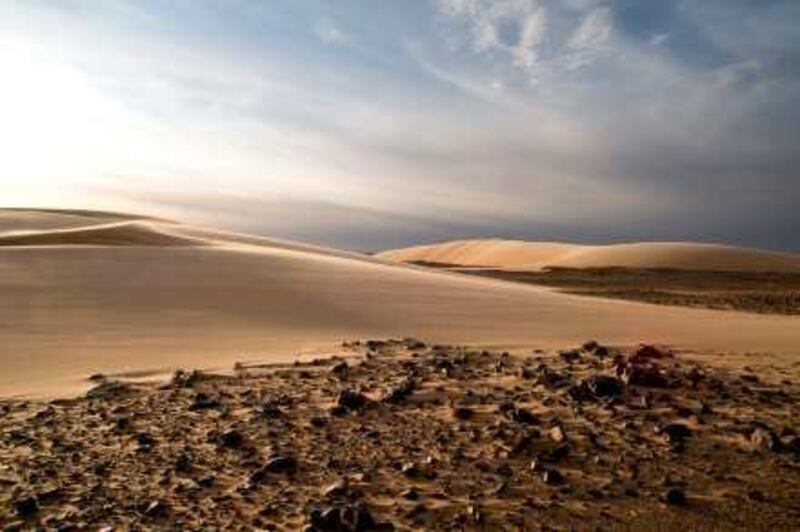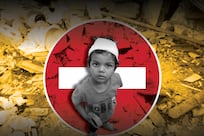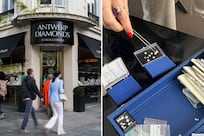"Hit the gas hard and stay on my tracks," our driver orders into the radio before stepping on the accelerator and catapulting us up a long and narrow wadi of red sand rising between two rocky plateaus. Tension grips the passengers as the vehicle fishtails wildly and as our driver assumes the air and intensity of a pilot navigating severe turbulence. He shoots up a dune, and nearly stalls in a patch of soft sand near the top before turning the vehicle on a downwards plummet at full throttle back towards the rising wadi. "We need to get more speed," he says, growling between his teeth. Following a violent tussle with the steering wheel and a near collision with the face of a rock, the jeep ascends the wadi to the top of one of the plateaus. "Voilà!" exclaims retired Colonel Ahmed al Mestekawi, our expedition leader, as he parks the 4x4 at the edge of a cliff overlooking a desert plain stretching endlessly into the distance. Three other vehicles soon follow suit. Our motor caravan has reached the summit of the Gilf Kebir, a vast, 1,000m-high plateau system the size of Switzerland, located in the south-west corner of Egypt. It is the sixth day of a two-week expedition travelling deep into the heart of the Western Desert, a veritable no-man's landof extreme desolation sitting on the western flank of Egypt's narrow strip of verdant, inhabitable land.Extending west from the Nile into Libya and all the way from the Mediterranean Sea to Sudan, the Western Desert, also called the Libyan Desert, is one of the driest, most forbidding and least populated places on the planet. This vast area of towering dune fields and black conical mountains constitutes the other Egypt, which rarely features on tourists' itineraries. A single entity only in name, the Western Desert is actually a patchwork of smaller deserts that comprise one giant open-air museum that once thrived with life. Stone Age tools, rock art, pottery and fossilised marine life litter the ground in places where savannah and giant lakes existed before being overrun by sand around 5,000 years ago. It is a vast graveyard teeming with ghosts that still has not been thoroughly explored. Eccentric Egyptian and European adventurers entered the area in rapid succession during the late 19th and early 20th centuries in an attempt to uncover and map what had until then only been known to speculation. Stories of epic and flamboyant journeys on camelback, in biplanes and Model T Fords, along with missions deep into the desert which were undertaken by intelligence doyens of the Allied and Axis powers during the Second World War, helped to form a more coherent picture of this mysterious land. Steeped in legend, the area featured as the desert setting for Michael Ondaatje's The English Patient. Western Desert's foremost authority. "I can't be away from the desert for more than a few months at a time. I start to become - how do you say - a little bit crazy." Known among Bedouin, military types and oasis dwellers from the Mediterranean coast to Kharga Oasis in the south, Ahmed is a man whose life reads like that of a fictional character from a novel. For 18 years, from 1977 to 1995, he worked as a patrol agent for the Egyptian border intelligence forces in the Western Desert, hunting smugglers and drug traffickers. After a number of spectacular seizures, some undertaken single-handedly, he became the most respected and feared patrol agent in the area, eventually rising to become commander of the entire Western Desert sector. He is also a former desert race rally driver and organiser, and recently had a prehistoric rock art site, which he discovered in 2002 - one of the largest in Africa - named after him. Today, Ahmed is the co-owner and manager of Zarzora Expeditions, a company he started in the mid-90s and which is one of a handful of Egyptian operators that takes travellers by 4x4 to the furthest reaches of the Western Desert. Here he combines and employs all of his various skills and talents gained from three decades of work in the desert. This experience and professionalism are reflected in the sheer scope of our journey. Our objective is to complete a 3,000km circumnavigation of the Egyptian portion of the Western Desert, taking us through several distinct regions. The Gilf Kebir plateau, located near Egypt's borders with Libya and Sudan, marks the midway point of our trip. After reconnoitring south of the plateau, our plan is to head north and then east towards the Nile through one of the largest sand dune fields on the planet - the Great Sand Sea. A dozen travellers, including myself, are accompanying Ahmed, who commands a crack team of driver-mechanic-cooks, each with at least a decade's experience travelling in Egypt's remotest corners. The 17 of us fill four jeeps that are stacked with every manner of provision imaginable and equipped with state-of-the-art GPS technology. We are required to carry with us all of our food, water and petrol. Crates of bottled water, bags of rice and pasta, cans of tuna, as well as vegetables, eggs, chicken and beef - and an entire small refrigerator, stove and oven - fill whatever excess space remain in our vehicles. If we run out of anything there will be no place to replenish it because no settlements exist here. Our caravan left Cairo six days earlier. Although we reached the edge of the Western Desert within an hour of leaving the Egyptian capital, the expedition did not begin in earnest until the next day when we had come to within 60km of Dakhla Oasis. Along Egypt's lonely Western Desert Road, Ahmed ordered the vehicles to stop so that the drivers could let air our of the tyres, making it easier for us to drive on the sand. After assembling the crew together and reciting the Fatiha - the opening verse of the Quran - we climbed back into the vehicles and slowly drove off the road. With the last trace of civilisation behind us, the already poignant sense of emptiness and isolation were amplified as we entered what could only be described as a world of Dali-like art. For days we coasted as if across an immeasurably vast canvas containing the most unusual formations of sand, rock and tangled wisps of cloud. All sense of boundaries and time vanished as one day melded into another and as we penetrated a realm whose windblown contours and sensory deprivations caused the mind to reel. We were periodically shaken out of our mental stupors by some strange object or archaeological find. On our third day, hundreds of kilometres from the nearest source of water, we found a site where 4,500-year-old pharaonic hieroglyphs were etched on a rocky outcrop. One of our fellow travellers, an explorer from Maadi named Mahmoud Marai excitedly proclaimed that this "categorically disproves that the ancient Egyptians never travelled or had any presence in the Western Desert." Mahmoud reminded us that any of the hundreds of other rock formations that surrounded us - most of which are yet unexplored - could contain similar relics. Prehistoric grindstones, empty jerry cans left over from the Second World War and an abandoned military vehicle from Britain's once Long Range Desert Group littered our path in succession. As fascinating as these moments were, the most consistently gripping aspect of our journey was Ahmed himself, whose knowledge and ability to function in the desert were simply astounding. Decked out in his trademark army fatigues, a beige keffiyah and Bollé sunglasses, he could predict the weather by simply looking at the glare of the early morning sun, could read tracks in the sand and tell you who or what made them and was able to cross menacing sand fields that would have swallowed a less talented driver. His commanding physical presence and seemingly primal instinct for survival were softened by his French educated, gentlemanly manner reminiscent of characters from old Egyptian cinema. One hour before sunset, Ahmed would choose a suitable location to make camp. Once the area was designated, he would align three of the four vehicles into a U-shape. The inside of that "U" space was to become our communal gathering area or tent. Within an hour, a large-scale, wind-protected space replete with kitchen, dinner table, chairs and tea and coffee station was erected. While this operation was under way, us travellers would set up our Egyptian army-issued canvas tents within close range of the vehicles and spend what time remained before dark, resting and attending to various tasks. By the time darkness descended and we emerged from our tents, Ahmed's team would be well into making dinner. These complex gastronomical dishes (for the desert) ranged from all manner of soups and pastas to vegetable and meat dishes. The entire team was a tightly organised and disciplined unit under the constant watchful eye of our former army colonel who led the entire expedition unyielding military precision. These leadership qualities came to the fore as we descended the western face of the Gilf Kebir and the mood among the crew became markedly more sober. We had entered what Ahmed and his cadre were calling "the trouble spot". Last September, a group of Europeans travelling to the same area with another outfitter were abducted by Chadian bandits who had crossed illegally into Egypt and stumbled upon the caravan near the Libyan border. During a harrowing 10-day ordeal the hostages were whisked back and forth between Libya, Chad and Sudan. A shoot-out ensued between the Sudanese Army and associates of the kidnappers, and the tourists were eventually let go, returning to Egypt frightened but unharmed. This incident, the third in just over a year, underscores how dicey travel to this corner of Egypt can be. Apart from small contingent of military observers stationed at isolated points along the Libyan and Sudanese borders, the Egyptian government has virtually no control over the area which smugglers frequently use as a short cut to dart back and forth between Libya and Sudan. "The security situation concerns us and we are watching closely to see how things unfold," Ahmed tells me, while scanning the horizon in the direction of the Libyan border. "In the meantime, if you plan properly, take precautions, and do things correctly, trips here can still be extremely safe. This is why you have to go with people who really know what they're doing - not just anybody with a 4x4 and GPS." Upon descending the plateau we travel south along a flat sheet of sand towards the twin mountains known as Peter and Paul. This last stretch of desert marks the climax of our trip and the southernmost point of the expedition. A visit to Jebel Uwainat - a 2,000m-high, granite and sandstone mountain, located further south and straddling the tri-border area of Egypt, Libya and Sudan - has been deemed too risky after the recent kidnapping. The mood among the drivers intensifies, and Ahmed begins scanning the sand to look for evidence of fresh tire tracks. Minutes later, someone sees what looks like a group of human figures on the horizon to our left. One of the drivers radios to tell the caravan to stop. He informs us that our unarmed Egyptian military escort has left the jeep to investigate the situation on foot. Ahmed reaches for his binoculars and steps out of the vehicle to have a look. Without saying a word, he jumps back in and drives at full speed towards the military officer, who is now wide-eyed with fear. "They're oil drums with rocks piled on top," says Ahmed, as he hands the incredulous young officer the binoculars to see for himself. We are as relieved as he is. That evening we camp near the base of a small hill after visiting a newly discovered cave containing breathtaking rock art. We are as distant from civilisation as most of us have ever been, caught in the bosom of an isolation and stillness that is strangely comforting. All thoughts of bandits, snakes and other trifles give way to a sky aglitter with stars, a home-cooked meal of kofta and bamya, and a sleep, which Ahmed assures me only moments before I'm already there, "will come on so fast and be so deep that you will remember it for the rest of your life".
The colonel's caravan
Feature Heading into the Great Sand Sea with a retired patrol agent from the Egyptian border intelligence forces.

More from The National




